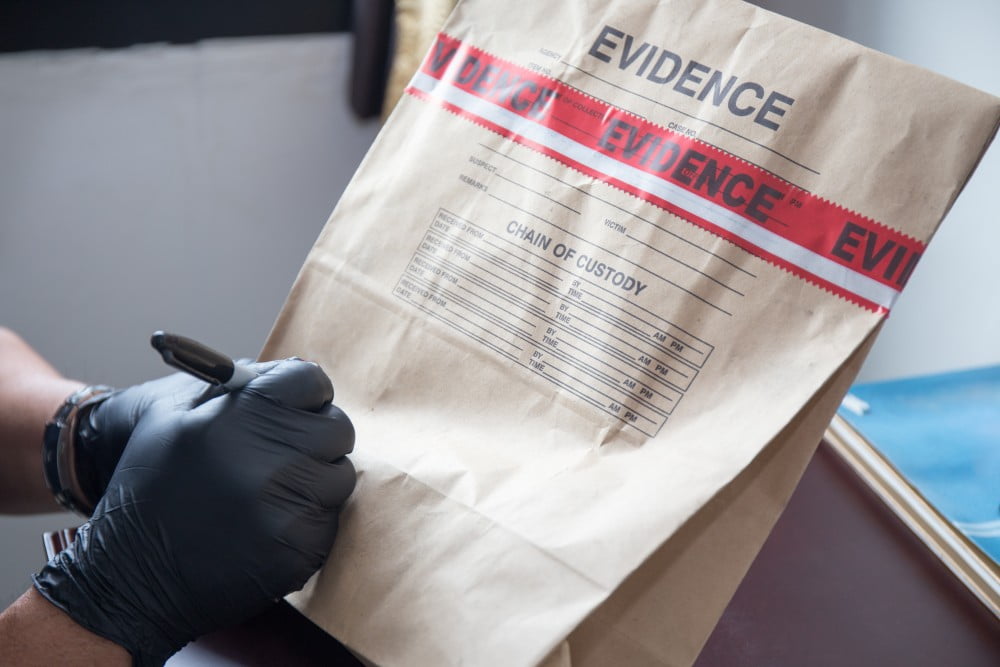What’s the difference between direct evidence and circumstantial evidence?
We’re all familiar with the phrase, “that’s just circumstantial,” implying that circumstantial evidence is unreliable and perhaps should not be used to prove a person’s guilt. You may be surprised to learn that, although circumstantial evidence is unreliable, it is also admissible in court and can be used to convict a person of a crime.
In this article, we will discuss the basics of direct evidence vs. circumstantial evidence, including:
- The definition of direct evidence,
- The definition of circumstantial evidence,
- Examples of direct vs. circumstantial evidence, and
- When circumstantial evidence is admissible in a criminal trial.
Types of Evidence in Criminal Cases
When a person is accused of a crime, the prosecution must use evidence to prove that the person committed the crime, and they must produce evidence that proves guilt beyond any reasonable doubt.
The evidence must be relevant, it must be reliable, and it must be admissible under the rules of evidence.
For example, hearsay statements like “Johnny told me he saw Bill shoot that man” are usually not admissible because they are not reliable and cannot be confirmed unless the person who made the statement is available to testify and subject to cross-examination.
Direct Evidence and Circumstantial Evidence: What’s the Difference?
Both direct evidence and circumstantial evidence are admissible as evidence against a defendant, however – assuming the evidence is relevant, more probative than prejudicial, and does not violate any other evidence rules.
Direct Evidence
Direct evidence is any physical evidence or witness testimony that directly proves the fact in question without a need to “connect the dots” or make inferences based on the evidence.
When there is an eyewitness who says that they saw the crime as it happened, and they identify the defendant as the perpetrator, or when there is a video recording of the defendant committing the crime, and if there is no reasonable explanation, jurors may easily conclude that a defendant is guilty beyond any reasonable doubt.
This doesn’t mean that all direct evidence is true – the jurors must still decide whether the eyewitness is 1) mistaken or 2) lying, and even video evidence can be misleading when taken out of context.
Circumstantial Evidence
Circumstantial evidence, although admissible in court, is more problematic than direct evidence. By its very nature, circumstantial evidence does not tell jurors what happened – it requires jurors to draw conclusions based on the evidence.
With circumstantial evidence, jurors must “connect the dots” to decide whether a defendant is guilty, making inferences based on the evidence that is presented.
If Witness 1 testifies that they saw a man in a red shirt rob the convenience store, and Witness 2 testifies that they saw the defendant, wearing a red shirt, running down the street where the robbery happened, that may be circumstantial evidence of guilt, but it does not directly prove that the defendant committed the robbery.
Without further evidence, direct or circumstantial, this testimony can at best raise suspicion of the defendant’s guilt, and suspicion is not proof beyond any reasonable doubt.
Is Circumstantial Evidence Admissible at Trial?
Circumstantial evidence is admissible in a criminal trial, and a defendant can be convicted based solely on circumstantial evidence.
To get a conviction based solely on circumstantial evidence, however, the prosecution will most likely need to produce multiple pieces of evidence or witness testimony that, when considered together, are consistent and point conclusively to the defendant’s guilt.
A prosecutor may use circumstantial evidence to prove:
- The elements of the crime,
- The existence of certain facts that make it more likely that the defendant committed the crime (the defendant was present at the scene of the crime or had stolen property in their possession, for example), or
- The defendant’s mental state or intent (which may also be an element of the crime, for example, “malice aforethought” in a murder trial).
Examples of Direct vs. Circumstantial Evidence
What’s the difference between direct and circumstantial evidence?
Let’s look at a few examples:
Direct evidence: An eyewitness testifies that they were present in the bank, witnessed the defendant point a gun at the bank teller and demand money, and identifies the bank robber as the defendant sitting at the defense table in the courtroom.
Circumstantial evidence: An eyewitness testifies that they witnessed the defendant get into a car outside of the bank and take off at a high rate of speed, although they did not witness the bank robbery. Did they just rob the bank, or did they just see the bank robber with a gun and they are getting themselves out of danger?
Direct evidence: Video surveillance from the Walmart store shows the defendant removing DVDs from the shelf and placing them into her jacket pocket before leaving the store without paying for the items.
Circumstantial evidence: Police stop the defendant in the parking lot and find DVDs in her jacket pocket. Along with the direct evidence- video footage of her placing the same DVDs in her pocket, it’s reasonable to conclude that she stole the DVDs that were found in her pocket. Without the direct video evidence, however, there could be multiple explanations for why the DVDs are in her pocket, and the circumstantial evidence alone is not conclusive.
State vs. Logan Circumstantial Evidence Charge
SC appellate opinions on circumstantial evidence repeatedly say, “the law makes no distinction between the weight or value to be given to either direct or circumstantial evidence,” which implies that circumstantial evidence is just as reliable as direct evidence.
Circumstantial evidence is not as reliable as direct evidence, however, and it has been the basis of many wrongful convictions, inviting jurors to convict a defendant based on guesses rather than conclusive evidence.
To counter this, the SC Supreme Court held in State v. Logan that, when a defendant requests it, the trial court must also instruct the jurors that:
- When the state relies on circumstantial evidence, “all of the circumstances must be consistent with each other,”
- When taken together, the circumstances “must point conclusively to the guilt of the accused beyond a reasonable doubt,” and
- If the “circumstances merely portray the defendant’s behavior as suspicious, the proof has failed” and the jurors must find the defendant not guilty.
When a defendant requests the “Logan charge” and the trial court refuses to give it, the appellate courts will reverse the defendant’s conviction on appeal (see State v. Logan, State v. Herndon, and State v. Dent).
Questions About Direct v. Circumstantial Evidence?
South Carolina criminal defense lawyer Kent Collins will investigate your charges, answer your questions, and do everything legally and ethically possible to get your case dismissed, win your case at trial, or find a resolution that is fair and reasonable.
Get in touch with Kent by phone at 803-808-0905 or use this form to reach him online to schedule your in-person consultation.

Schedule Your Free
In Person Consultation!
Contact Kent Collins

